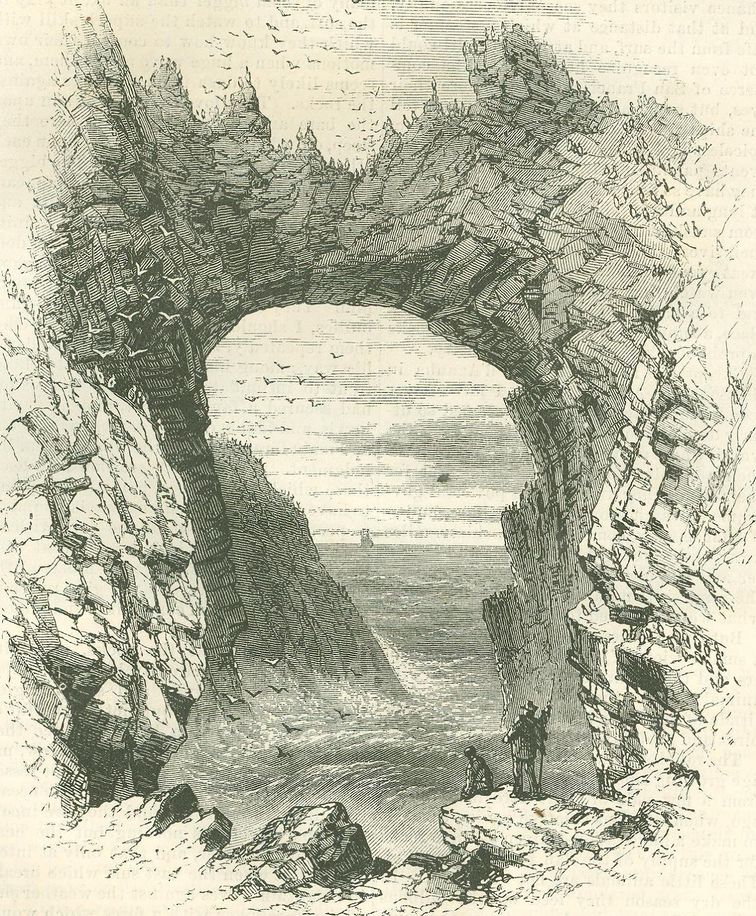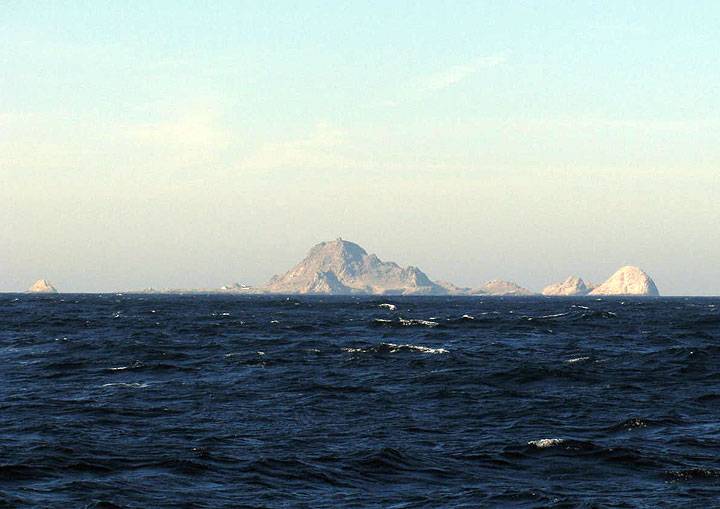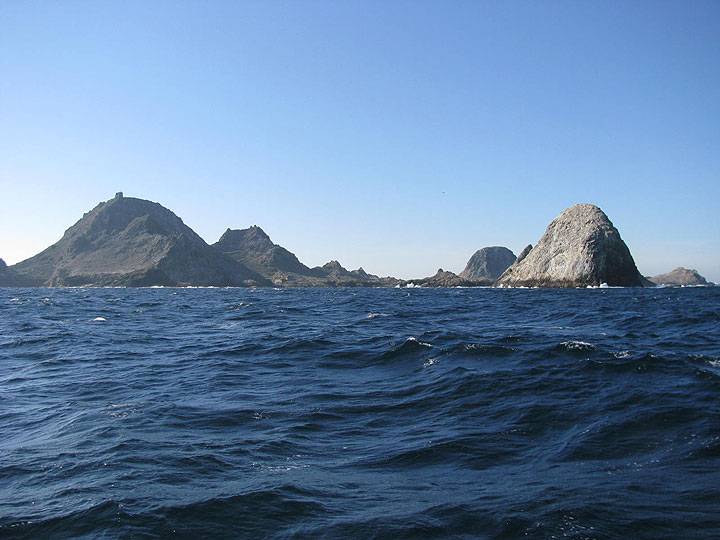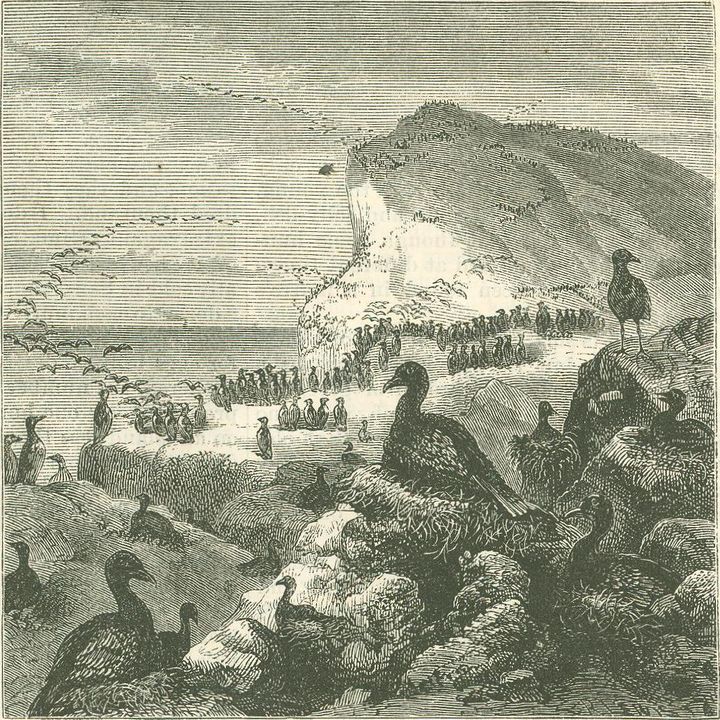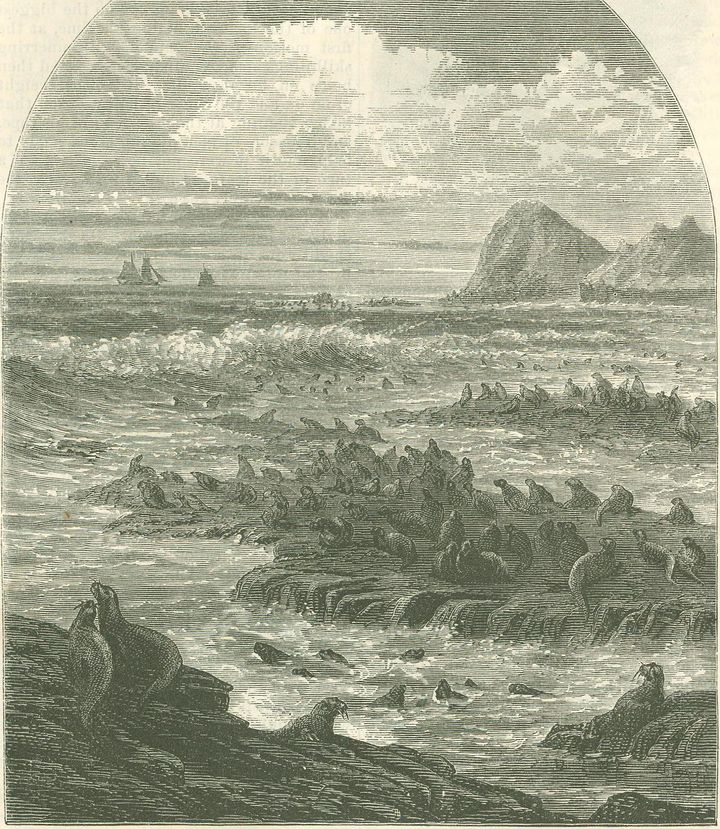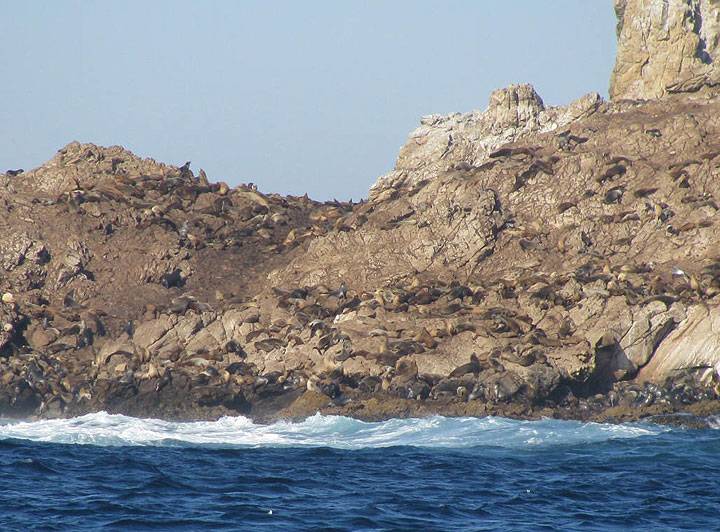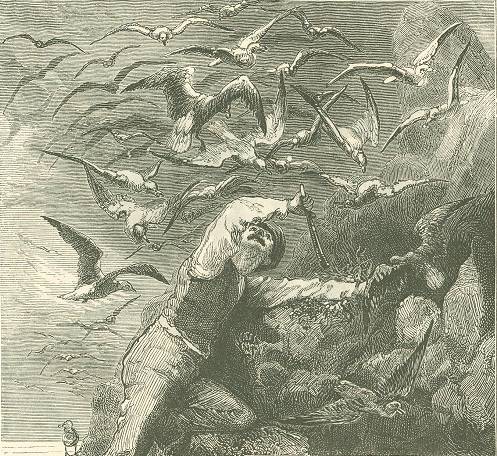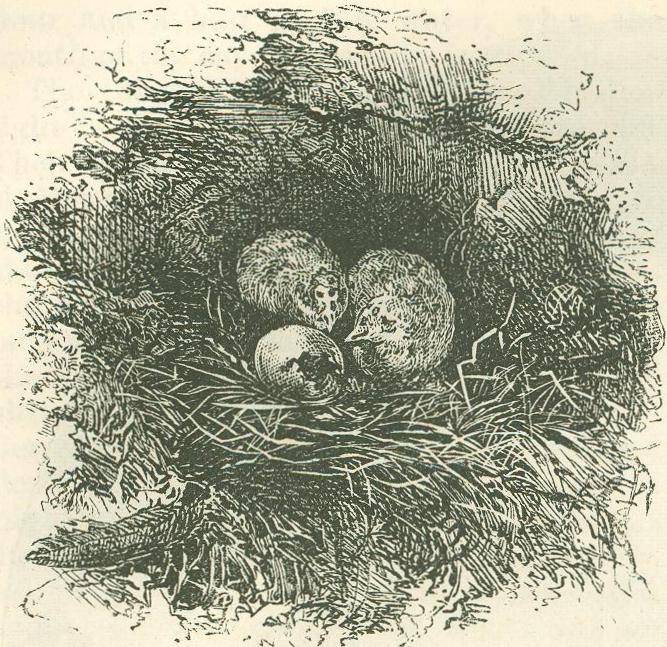Farallones Islands 1874
Historical Essay
by Charles Nordoff
from Harper’s New Monthly Magazine, April, 1874 (reposted from Digital History Project)
Arch at west end of Farallon Islands, 1874.
Farallones from ocean view east of the islands and west of the Golden Gate, 2007.
Photo: Chris Carlsson
If you approach the harbor of San Francisco from the west, your first sight of land will be a collection of picturesque rocks known as the Farallones, or, more fully, the Farallones de los Frayles. They are six rugged islets, whose peaks lift up their heads in picturesque masses out of the ocean, twenty-three and a half miles from the Golden Gate, the famous entrance of San Francisco Bay. Farallon is a Spanish word, meaning a small pointed islet in the sea.
These rocks, probably of volcanic origin, and bare and desolate, lie in a line from southeast to northwest—curiously enough the same line in which the islands of the Hawaiian or Sandwich Island group have been thrown up. Geologists say they are the outcrop of an immense granite dike.
The southernmost island, which is the largest just as Hawaii, the southernmost of the Sandwich Island group, is also the biggest—extends for nearly a mile east and west, and is 340 feet high. It is composed of broken and water-worn rocks, forming numerous angular peaks, and having several caves; and the rock, mostly barren and bare, has here and there a few weeds and a little grass. At one point there is a small beach, and at another a depression; but the fury of the waves makes landing at all times difficult, and for the most part impossible.
The Farallones are seldom visited by travelers or pleasure-seekers. The wind blows fiercely here most of the time; the ocean is rough; and to persons subject to seasickness the short voyage is filled with the misery of that disease. Yet they contain a great deal that is strange and curious. On the highest point of the South Farallon the government has placed a light-house, a brick tower seventeen feet high, surmounted by a lantern and illuminating apparatus. It is a revolving white light, showing a prolonged flash of ten seconds duration once in a minute. The light is about 360 feet above the sea, and with a clear atmosphere is visible, from a position ten feet high, twenty-five and a half miles distant; from an elevation of sixty feet it can be seen nearly thirty-one miles away; and it is plainly visible from Sulphur Peak on the main-land, 3471 feet high and sixty-four and a half miles distant. The light-house is in latitude 37° 41' 8" north and longitude 122° 59' 05" west.
On our foggy Western coast it has been necessary to place the light-houses low, because if they stood too high their light would be hidden in fog-banks and low clouds. The tower on the South Farallon is therefore low; and this, no doubt, is an advantage also to the light-keepers, who are less exposed to the buffetings of the storm than if their labor and care lay at a higher elevation.
As the Farallones lie in the track of vessels coming from the westward to San Francisco, the light is one of the most important, as it is also one of the most powerful on our Western coast; and it is supplemented by a fog-whistle which is one of the most curious contrivances of this kind in the world. It is a huge trumpet, six inches in diameter at its smaller end, and blown by the rush of air through a cave or passage connecting with the ocean.
One of the numerous caves worn into the rocks by the surf had a hole at the top, through which the incoming breakers violently expelled the air they carried before them. Such spout-holes are not uncommon on rugged, rocky coasts. There are several on the Mendocino coast, and a number on the shores of the Sandwich Islands. This one, however, has been utilized by the ingenuity of man. The mouth-piece of the trumpet or fog-whistle is fixed against the aperture in the rock, and the breaker, dashing in with venomous spite, or the huge bulging wave which would dash a ship to pieces and drown her crew in a single effort, now blows the fog-whistle and warns the mariner off. The sound thus produced has been heard at a distance of seven or eight miles. It has a peculiar effect, because it has no regular period; depending upon the irregular coming in of the waves, and upon their similarly irregular force, it is blown somewhat as an idle boy would blow his penny trumpet. It ceases entirely for an hour and a half at low water, when the mouth of the cave or passage is exposed.
The life of the keepers of the Farallon light is singularly lonely and monotonous. Their house is built somewhat under the shelter of the rocks, but they live in what to a landsman would seem a perpetual storm; the ocean roars in their ears day and night; the boom of the surf is their constant and only music ; the wild scream of the sea-birds, the howl of the sea-lions, the whistle and shriek of the gale, the dull threatening thunder of the vast breakers, are the dreary and desolate sounds which lull them to sleep at night, and assail their ears when they awake. In the winter months even their supply vessel, which for the most part is their only connection with the world, is sometimes unable to make a landing for weeks at a time. Chance visitors they see only occasionally, and at that distance at which a steamer is safe from the surf, and at which a girl could not even recognize her lover. The commerce of San Francisco passes before their eyes, but so far away that they cannot tell the ships and steamers which sail by them voiceless and without greeting; and of the events passing on the planet with which they have so frail a social tie they learn only at long and irregular intervals. The change from sunshine to fog is the chief variety in their lives; the hasty landing of supplies the great event in their months. They cannot even watch the growth of trees and plants; and to a child born and reared in such a place, a sunny lea under the shelter of rocks is probably the ideal of human felicity.
Farallones from the northwest, 2007.
Photo: Chris Carlsson
from Harper's Magazine, 1874
Except the rock of Tristan d'Acunha in the Southern Atlantic Ocean, I have never seen an inhabited spot which seemed so utterly desolate, so entirely separated from the world, whose people appeared to me to have such a slender hold on mankind Yet for their solace they know that a powerful government watches over their welfare, and—if that is any Comfort—that, thirty miles away, there are lights and music and laughter and singing, as well as crowds, and all the anxieties and annoyances incidental to what we are pleased to call civilization.
But though these lonely rocks contain but a small society of human beings—the keepers and their families—they are filled with animal life; for they are the home of a multitude of sea-lions, and of vast numbers of birds and rabbits.
The rabbits, which live on the scanty herbage growing among the rocks, are descended from a few pair brought here many years ago, when some speculative genius thought to make a huge rabbit-warren of these rocks for the supply of the San Francisco market. These little animals are not very wild. In the dry season they feed on the bulbous roots of the grass, and sometimes they suffer from famine. In the winter and spring they are fat, and then their meat is white and sweet. During summer and fall they are not fit to eat.
They increase very rapidly, and at not infrequent intervals they overpopulate the island, and then perish by hundreds of starvation and the diseases which follow a too meager diet. They are of all colors, and though descended from some pairs of tame white rabbits, seem to have reverted in color to the wild race from which they originated.
The Farallones have no snakes. The sea-lions, which congregate by thousands upon the cliffs, and bark and howl and shriek and roar in the caves and upon the steep sunny slopes, are but little disturbed, and one can usually approach them within twenty or thirty yards. It is an extraordinarily interesting sight to see these marine monsters, many of them bigger than an ox, at play in the surf, and to watch the superb skill with which they know how to control their own motions when a huge wave seizes them, and seems likely to dash them to pieces against the rocks. They love to lie in the sun upon the bare and warm rocks; and here they sleep, crowded together, and lying upon each other in inextricable confusion. The bigger the animal, the greater his ambition appears to be to climb to the highest summit ; and when a huge, slimy beast has with infinite squirming attained a solitary peak, he does not tire of raising his sharp-pointed, maggot-like head, and complacently looking about him. They are a rough set of brutes—rank bullies, I should say; for I have watched them repeatedly, as a big fellow shouldered his way among his fellows, reared his huge front to intimidate some lesser seal which had secured a favorite spot, and first with howls, and if this did not suffice, with teeth and main force, expelled the weaker from his lodgment. The smaller sea-lions, at least those which have left their mothers, appear to have no rights which any one is bound to respect. They get out of the way with an abject promptness which proves that they live in terror of the stronger members of the community; but they do not give up their places without harsh complaints and piteous groans.
Sea lions on the Farallones, 1874 rendition.
Sea lions and seals basking on the Farallones, 2007.
Photo: Chris Carlsson
Plastered against the rocks, and with their lithe and apparently boneless shapes conformed to the rude and sharp angles, they are a wonderful, but not a graceful or pleasing sight. At a little distance they look like huge maggots, and their slow, ungainly motions, upon the land do not lessen this resemblance. Swimming in the ocean, at a distance from the land they are inconspicuous objects, as nothing but the head shows above water, and that only at intervals. But when the vast surf which breaks in mountain waves against the weather side of the Farallones with a force which would in a single sweep dash to pieces the biggest Indiaman—when such a surf, vehemently and with apparently irresistible might, lifts its tall white head, and with a deadly roar lashes the rocks half-way to their summit—then it is a magnificent sight to see a dozen or half a hundred great sea-lions at play in the very midst and fiercest part of the boiling surge, so completely masters of the situation that they allow themselves to be carried within a foot or two of the rocks, and at the last and imminent moment, with an adroit twist of their bodies, avoid the shock, and, diving, reappear beyond the breaker.
As I sat, fascinated with this weird spectacle of the sea-lions, which seemed to me like an unhallowed prying into some hidden and monstrous secret of nature, I could better realize the fantastic and brutal wildness of life in the earlier geological ages, when monsters and chimeras dire wallowed about our unripe planet, and brute force of muscles and lungs ruled among the populous hordes of beasts which, fortunately for us, have perished, leaving us only this great wild sea-beast as a faint reminiscence of their existence. I wondered what Dante would have thought—and what new horrors his gloomy imagination would have conjured, could he have watched this thousand or two of sea lions at their sports.
The small, sloping, pointed head of the creature gives it, to me, a peculiarly horrible appearance. It seems to have no brain, and presents an image of life with the least intelligence. It is in reality not without wits, for one needs only to watch the two or three specimens in the great tank at Wood-ward's Gardens, when they are getting fed, to see that they instantly recognize their keeper, and understand his voice and motions. But all their wit is applied to the basest uses. Greed for food is their ruling passion, and the monstrous lightning-like lunges through the water, the inarticulate shrieks of pleasure or of fury as he dashes after his food or comes up without it, the wild, fierce eyes, the eager and brutal vigor with which he snatches a morsel from a smaller fellow-creature, the reliance on strength alone, and the abject and panic-struck submission of the weaker to the stronger—all this shows him a brute of the lowest character.
Yet there is a wonderful snake-like grace in the lithe, swift motions of the animal when he is in the surf. You forget the savage blood-shot eyes, the receding forehead, the clumsy figure and awkward motion as he wriggles up the steep rocks, the moment you see him at his superb sport in the breakers. It seemed to me that he was another creature. The eye looks less baleful, and even joyous; every movement discloses conscious power; the excitement of the sport sheds from him somewhat of the brutality which re-appears the moment he lands or seeks his food.
So far as I could learn, the Farallon sea-lions are seldom disturbed by men seeking profit from them. In the egging season one or two are shot to supply oil to the lamps of the eggers; and occasionally one is caught for exhibition on the main-land. How do they catch a sea-lion? Well, they lasso him; and, odd as it sounds, it is the best and probably the only way to capture this beast. An adroit Spaniard, to whom the lasso or reata is like a fifth hand, or like the trunk to the elephant, steals up to a sleeping congregation, fastens his eye on the biggest one of the, lot, and, biding his time, at the first motion of the animal, with unerring skill flings his loose rawhide noose, and then holds on for dear life. It is the weight of an ox and the vigor of half a dozen that he has tugging at the other end of his rope, and if a score of men did not stand ready to help, and if it were not possible to take a turn of the reata around a solid rock, the seal would surely get away.
Moreover, they must handle the beast tenderly, for it is easily injured. Its skin, softened by its life in the water, is quickly cut by the rope; its bones are easily broken; and its huge frame, too rudely treated, may be so hurt that the life dies out of it. As quickly as possible the captured sea-lion is stuffed into a strong box or cage, and here, in a cell too narrow to permit movement, it roars and yelps in helpless fury, until it is transported to its tank. Wild and fierce as it is, it seems to reconcile itself to the tank life very rapidly. If the narrow space of its big bath-tub frets it, you do not perceive this, for hunger is its chief passion, and with a moderately full stomach the animal does well in captivity, of course with sufficient water.
The South Farallon is the only inhabited one of the group. The remainder are smaller; mere rocky points sticking up out of the Pacific. The Middle Farallon is a single rock, from fifty to sixty yards in diameter, and twenty or thirty feet above the water. It lies two and a half miles northwest by west from the light-house. The North Farallon consists in fact of four pyramidal rocks, whose highest peak, in the center of the group, is one hundred and sixty feet high; the southern rock of the four is twenty feet high. The four have a diameter of 160,185, 125, and 35 yards respectively, and the most northern of the islets bears north 64° west from the Farallon light, six and three-fifths miles distant.
All the islands are frequented by birds; but the largest, the South Farallon, on which the light-house stands is the favorite resort of these creatures, who come here in astonishing numbers every summer to breed; and it is to this island that the eggers resort at this season to obtain supplies of sea-bird's eggs for the San Francisco market, where they have a regular and large sale.
The birds which breed upon the Farallones are gulls, murres, shags, and sea-parrots, the last a kind of penguin. The eggs of the shags and parrots are not used, but the eggers destroy them to make more room for the other birds. The gull begins to lay about the middle of May, and usually ten days before the murre. The gull makes a rude nest of brush and sea-weed upon the rocks; the murre does not take even this much trouble, but lays its eggs in any convenient place on the bare rocks.
The gull soon gets done, but the murre continues to lay for about two mouths. The egging season lasts; therefore, from the 10th or 20th of May until the last of July. In this period the egg company which has for eighteen years worked this field gathered in 1872 17,952 dozen eggs, and in 1873 15,203 dozen. These brought last year in the market an average of twenty-six cents per dozen. There has been, I was assured by the manager, no sensible decrease in the number of the birds or the eggs for twenty years.
From fifteen to twenty men are employed during the egging season in collecting and shipping the eggs. They live on the island during that time in rude shanties near the usual landing-place. The work is not amusing, for the birds seek out the least accessible places, and the men must follow, climbing often where a goat would almost hesitate. But this is not the worst. The gull sits on her nest, and resists the robber who comes for her eggs, and he must take care not to get bitten. The murre remains until her enemy is close upon her; then she rises with a scream which often startles a thousand or two of birds, who whirl up into the air in a dense mass, scattering filth and guano over the eggers.
Nor is this all the gulls, whose season of breeding is soon past, are extravagantly fond of murre eggs; and these rapacious birds follow the egg-gatherers, hover over their heads, and no sooner is a murre's nest uncovered than the bird swoops down, and the egger must be extremely quick, or the, gull will snatch the prize from under his nose. So greedy and eager are the gulls that they sometimes even wound the eggers, striking them with their beaks. But if the gull gets an egg, he flies up with it, and, tossing it up, swallows what he can catch, letting the shell and half its contents fall in a shower upon the luckless and disappointed egger below.
Finally, so difficult is the ground that it is impossible to carry baskets. The egger therefore stuffs the eggs into his shirt bosom until he has as many as he can safely carry, then clambers over rocks and down precipices until he comes to a place of deposit, where he puts them into baskets, to be carried down to the shore, where there are houses for receiving them. But so skillful and careful are the gatherers that but few eggs are broken.
The gathering proceeds daily, when it has once begun, and the whole ground is carefully cleared off, so that no stale eggs shall remain. Thus if a portion of the ground has been neglected for a day or two, all the eggs must be flung into the sea, so as to begin afresh. As the season advances, the operations are somewhat contracted, leaving a part of the island undisturbed for breeding; and the gathering of eggs is stopped entirely about a month before the birds usually leave the island, so as to give them all an opportunity to hatch out a brood.
Contest for the eggs, 1874.
Harper's Magazine
The murre is not good to eat. If undisturbed it lays two eggs only; when robbed, it will keep on laying until it has produced six or even eight eggs; and the manager of the islands told me that he had found as many as eight eggs forming in a bird's ovaries when he killed and opened it in the beginning of the season. The male bird regularly relieves the female on the nest, and also watches to resist the attacks of the gull, which not only destroys the eggs, but also eats the young. The murre feeds on sea-grass and jelly-fish, and I was assured that though some hundreds had been examined at different times, no fish had ever been found in a murre's stomach.
The bird is small, about the size of a half-grown duck, but its egg is as large as a goose egg. The egg is brown or greenish, and speckled. When quite fresh, it has no fishy taste, but when two or three days old, the fishy taste becomes perceptible. They are largely used in San Francisco by the restaurants and bakers, and for omelets, cakes, and custards.
Gull's nest.
Harper's Magazine, 1874.
During the height of the egging season the gulls hover in clouds over the rocks, and when a rookery is started, and the poor birds leave their nests by hundreds, the air is presently alive with gulls flying off with the eggs, and the eggers are sometimes- literally drenched.
There is thus inevitably a considerable waste of eggs. I asked some of the eggers how many murres nested on the South Farallon, and they thought at least one hundred thousand. I do not suppose this an extravagant estimate, for, taking the season of 1272, when 17,952 dozen eggs were actually sold in San Francisco, and allowing half a dozen to each murre, this would give nearly 36,000 birds; and adding the proper number for eggs broken, destroyed by gulls, and not gathered, the number of murres and gulls is probably over one hundred thousand. This on an island less than a mile in its greatest diameter, and partly occupied by the light house and fog-whistle and their keepers, and by other birds and a large number of sea-lions!
When they are done laying, and when the young can fly, the birds leave the island, usually going off together. During the summer and fall they return in clouds at intervals, but stay only a few days at a time, though there are generally a few to be found at all times; and I am told that eggs in small quantities can be found in the fall.
The murre does not fly high, nor is it a very active bird, or apparently of long flight. But the eggers say that when it leaves the island they do not know whither it goes, and they assert that it is not abundant on the neighboring coast. The young begin to fly when they are two weeks old, and the parents usually take them immediately into the water.
The sea-parrot has a crest, and somewhat resembles a cockatoo. Its numbers on the South Farallon are not great. It makes a nest in a hole in the rocks, and bites if it is disturbed.
The island was first used as a sealing station; but this was not remunerative, there being but very few fur seal, and no sea-otters. This animal, which abounds in Alaska, and is found occasionally on the southern coast of California, frequents the masses of kelp which line the shore; but there is no kelp about the Farallones.
In the early times of California, when provisions were high-priced, the egg-gatherers sometimes got great gains. Once, in 1853, a boat absent but three days brought in one thousand dozen, and sold the whole cargo at a dollar a dozen; and in one season thirty thousand dozen were gathered, and brought an average of but little less than this price.
Of course there was an egg war. The prize was too great not to be !struggled for; and the rage of the conflicting claimants grew to such a pitch that guns were used and lives were threatened, and at last the government of the United States had to interfere to keep the peace. But with lower prices the strife ceased; the present company bought out, I believe, all adverse claims, and for the last fifteen or sixteen years peace has reigned in this part of the county of San Francisco—for these lonely islets are a part of the same county .with the metropolis of the Pacific.

